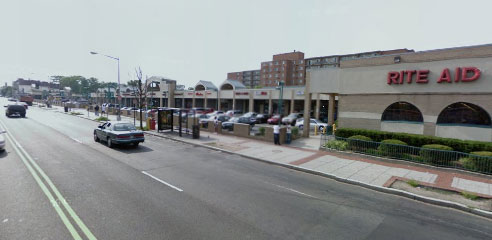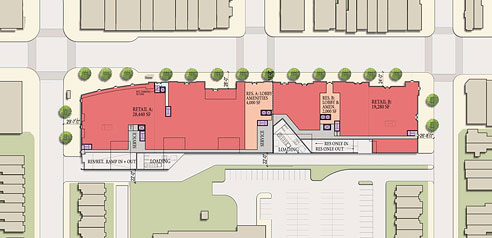H Street to get replacement for eyesore strip mall
Historic row houses and other old buildings line most of H Street, NE, though with periodic interruptions where more recent modifications have scarred the building fabric such as Meads Row. But one block is all scar: the south side of H between 8th and 10th Streets, which has a one-story, generic strip mall with parking in front, ironically named the H Street Connection.
This isn’t appropriate for a major, developing, urban commercial corridor that’s slated for a streetcar. Fortunately, developer Rappaport Companies is moving ahead with a Planned Unit Development, designed by Torti Gallas and Partners, to construct a retail and residential mixed-use building on the block conaining 409 apartments and 50,000 square feet of retail.
The community requested that more of the building’s massing concentrate to the rear of the block, giving it a lower feel along H Street to better match the existing row houses. It also uses a “sawtooth” pattern, like many other recent buildings in DC, to make the structure read like multiple buildings. Except for the corner structure at 8th and H (pictured above), most of the building will use a masonry facade with a traditional look.
The current plans maintain the existing curb cuts on 8th and 10th behind the building, and locate the garage ramps in that alley. (It’s not clear if it’s a public alley or part of the private property.) Some neighbors have recommended an entrance on H instead. Today, there’s a vehicular entrance there, opposite 9th Street, which ends at the site. Given that this is already an intersection, that makes some sense, but it’d still create a better pedestrian and streetcar experience for cars to come in and out using the much less busy side streets.
The garage will contain 520 spaces, of which 170 will be public. This is much more than zoning requires; if the streetcar were already here, it wouldn’t make sense to build so many, but at the moment attracting people to H Street often requires facilitating car storage, and Rappaport should be free to build the spaces it thinks the market demands. However, the community shouldn’t push for even more parking spaces as one of their public amenities under the PUD process, as some have suggested.
Other potential community benefits (MS Word) that have come up in neighborhood discussions include Zipcar spaces, a bike sharing station, LEED certification, grants to improve facades on the opposite side of H, funding for an H Street historic survey, or a public toilet to dissuade people from going in the alleys. Those all sound reasonable, and better than even more parking in a project that has plenty for every resident, lots of shoppers, and even some neighbors.
ANCs 6C and 6A split the H Street corridor, and 6C Commissioner Ryan Velasco has written a report about improving the community benefits that come from PUDs. He’s also very closely involved with the neighborhood’s negotiations on this project. Even though DC hasn’t yet made any of the reforms Velasco suggested, hopefully the community can negotiate a good benefits package and let this project reconnect the giant gap created by the H Street Connection.



